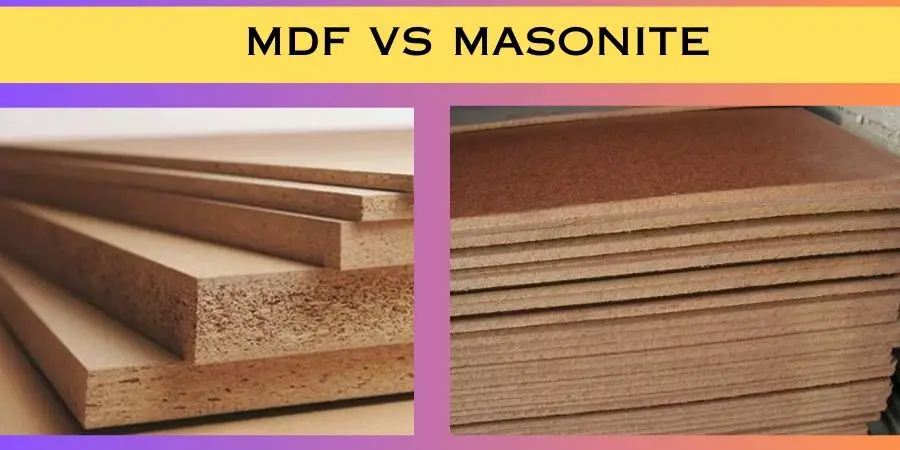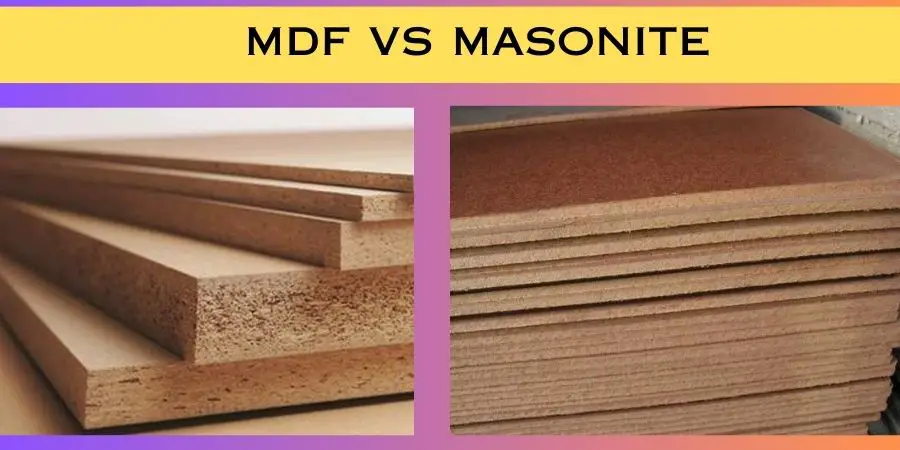When it comes to selecting a material for your woodworking project, there are many options available.
Two of the most popular choices are MDF and Masonite. While they may seem similar at first glance, there are some key differences between the two.
In this article, we’ll take a closer look at MDF vs Masonite and help you make an informed decision for your next project.

Table of Contents
What is MDF?
MDF, or Medium-Density Fiberboard, is a composite wood product made from wood fibers and resin.
It is known for its smooth surface, uniform density, and excellent machinability. MDF is often used in furniture, cabinetry, and decorative molding, among other applications.
What is Masonite?
Masonite, on the other hand, is a brand name for a type of hardboard made from wood fibers and resin.
It is similar to MDF in many ways but has a more dense, hard surface. Masonite is commonly used as a painting surface, as well as for interior doors, siding, and roofing.
MDF vs Masonite: Pros and Cons
MDF Pros:
- Smooth surface: MDF has a very smooth and uniform surface that is ideal for painting or laminating.
- Easy to work with: MDF can be easily cut, drilled, and shaped with basic woodworking tools.
- Affordable: MDF is widely available and generally more affordable than other materials.
MDF Cons:
- Not as durable: MDF is less dense than Masonite, which means it’s not as durable and may not hold up well over time.
- Prone to chipping: MDF’s edges can be prone to chipping, and may require special attention to achieve a finished look.
- Susceptible to moisture: MDF can absorb moisture, which can cause it to swell or warp.
Masonite Pros:
- Durable: Masonite is more dense than MDF, making it more durable and resistant to moisture and rot.
- Texture: Masonite has a harder, more textured surface that is more resistant to dents and scratches.
- Versatile: Masonite can be used for a variety of applications, from exterior siding to artwork backing.
Masonite Cons:
- More expensive: Masonite is generally more expensive than MDF, which can make it less accessible to some woodworkers.
- Harder to work with: Masonite can be more difficult to cut and shape due to its density.
- Heavier: Masonite is heavier than MDF, which may not be ideal for certain projects.
MDF vs Masonite: The Key Differences
While MDF and Masonite have some surprising similarities, there are also some important differences to consider. In this article, we’ll take a closer look at the differences between these two materials.
Density and Durability
One of the most significant differences between MDF and Masonite is their density and durability. MDF has a lower density than Masonite, which can make it easier to work with but also less durable.
Masonite, on the other hand, has a higher density and is more resistant to moisture and rot, making it a popular choice for exterior applications.
Appearance and Finish
Another key difference between MDF and Masonite is their appearance and finish. MDF has a very smooth and uniform surface, which makes it ideal for painting or laminating.
However, its edges can be prone to chipping and may require special attention to achieve a finished look.
Masonite, on the other hand, has a harder, more textured surface that may require more preparation before painting or finishing. Its edges are generally smoother and more durable than MDF.
Price and Availability
Finally, price and availability are important factors to consider when choosing between MDF and Masonite.
MDF is widely available at most home improvement stores and is generally more affordable than Masonite.
Masonite may be a better choice if durability is a concern, but it can be harder to find and may be more expensive.
MDF and Masonite: The Surprising Similarities
While MDF and Masonite may seem like vastly different materials at first glance, they actually share a number of surprising similarities.
Composition
One of the most striking similarities between MDF and Masonite is their composition.
Both materials are made from wood fibers and resin, which are compressed and heated to form a dense, hard surface.
This means that both MDF and Masonite are essentially composite materials, rather than natural woods.
Versatility
Another similarity between MDF and Masonite is their versatility.
Both materials can be used for a wide range of applications, from furniture and cabinetry to decorative molding and painting surfaces.
This makes them popular choices for DIY enthusiasts and professional woodworkers alike.
Ease of Machining
Both MDF and Masonite are known for their excellent machinability.
They can be cut, drilled, and shaped with relative ease, making them ideal for intricate woodworking projects.
In addition, both materials can be painted or laminated to achieve a variety of finishes.
Affordability
Finally, both MDF and Masonite are relatively affordable compared to many natural woods. This makes them popular choices for projects where cost is a consideration, such as custom cabinetry or decorative paneling.
MDF vs Masonite: Different Uses
MDF and Masonite have distinct differences in their composition, density, and durability, which makes them suited for different applications.
Here are some common uses for both materials:
MDF Uses:
- Cabinets and furniture: MDF is often used to make cabinets, shelving, and other furniture pieces. Its uniform texture makes it ideal for painting, and it can be cut and drilled with ease.
- Decorative trim: MDF is also a popular choice for interior decorative trim, such as crown molding or baseboards. It can be molded into intricate shapes and designs with precision.
- Flooring: MDF is sometimes used as a subflooring material in areas where moisture isn’t a concern, such as on top of concrete or in basements.
- Soundproofing: MDF’s density makes it a good material for soundproofing walls or floors.
Masonite Uses:
- Exterior siding: Masonite’s high density and durability make it an ideal choice for exterior siding. It can withstand moisture and rot, and it can be painted to match any style.
- Backing for artwork: Masonite is often used as a backing for paintings, drawings, and other artwork. Its smooth surface and stability make it a popular choice.
- Decorative paneling: Masonite can be used for decorative paneling on walls or ceilings. Its harder surface makes it more resistant to dents and scratches.
- Doors: Masonite doors are popular for their durability and affordability, and can be found in a range of styles.





